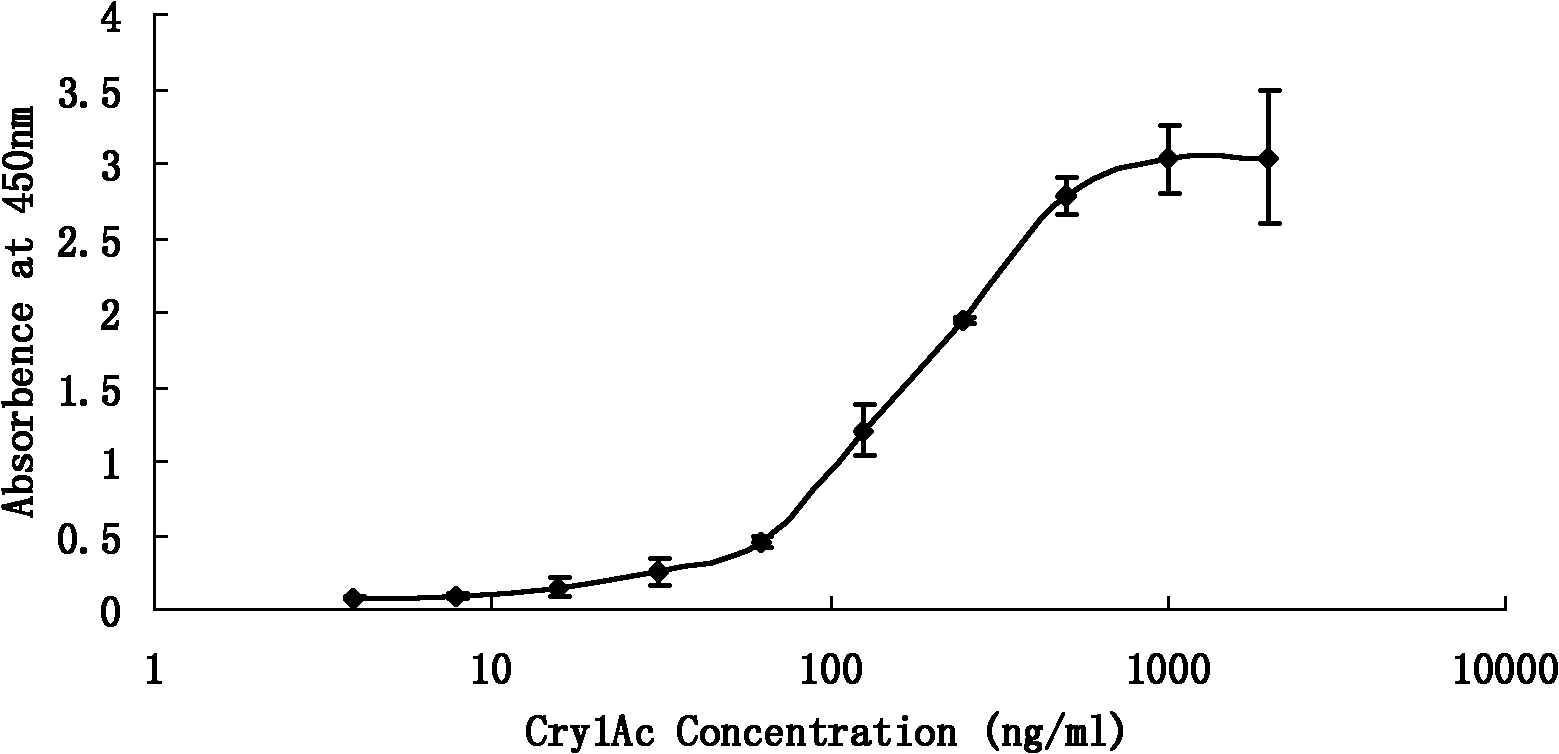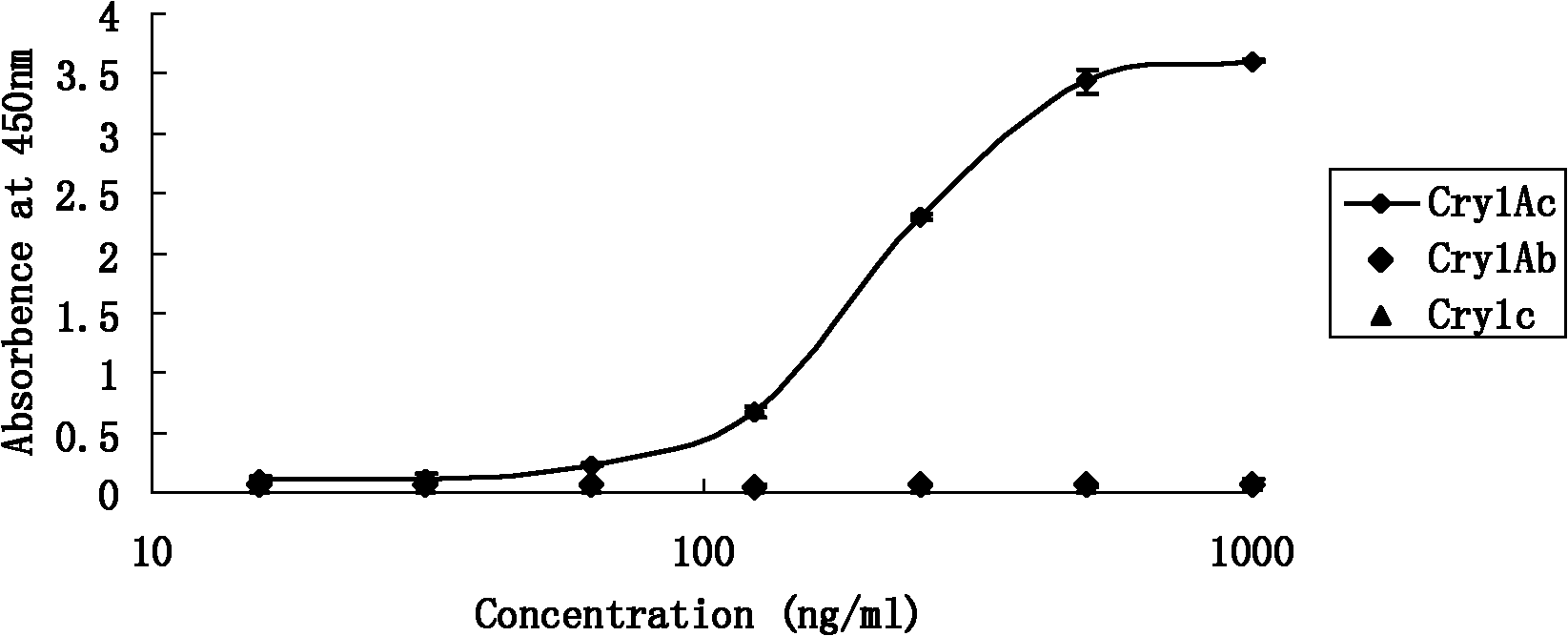Insecticidal crystal protein CrylAc enzyme linked immunosorbent detection kit
A technology of enzyme-linked immunosorbent adsorption and insecticidal crystal protein, which is applied in the direction of measuring devices, material analysis and instruments through observation of the impact on chemical indicators, to achieve the effect of reducing detection costs
- Summary
- Abstract
- Description
- Claims
- Application Information
AI Technical Summary
Problems solved by technology
Method used
Image
Examples
Embodiment 1
[0026] Example 1: Production of insecticidal crystal protein Cry1Ac rabbit monoclonal antibody
[0027] 1. Cry1Ac protein immunized rabbits
[0028] Mix 500 μg of Cry1Ac protein with the same amount of complete Freund’s adjuvant, emulsify it as the immunogen, and inject it subcutaneously at five points on the back of rabbits (three New Zealand white rabbits). On day 56, 200 μg of Cry1Ac protein was mixed with incomplete Freund's adjuvant and immunized in the same way.
[0029] 2. cell fusion
[0030] Blood was collected from the rabbit after the fifth immunization and the serum was separated to measure the immune titer, and a rabbit with a higher titer was selected for cell fusion. Ten days before the rabbit spleen was taken for cell fusion, a booster immunization was carried out to the rabbit, and then a sterile spleen was taken. Spleen cells and myeloma cells in the logarithmic growth phase were selected for fusion, the fusion agent was 50% PEG, and HAT was used as ...
Embodiment 2
[0033]Example 2: Production of insecticidal crystal protein Cry1Ac rabbit polyclonal antibody
[0034] Mix 500 μg of Cry1Ac protein with the same amount of complete Freund's adjuvant, emulsify it completely as the immunogen, and inject subcutaneously at five points on the back of rabbits (two New Zealand white rabbits). On day 56, 200 μg of Cry1Ac protein was mixed with incomplete Freund's adjuvant and immunized in the same way. Blood was collected from the rabbit after the fifth immunization and the serum was separated to determine the immune titer. A rabbit with a higher titer was selected for two booster immunizations, and then the whole blood of the rabbit was obtained. Rabbit whole blood was first separated from serum, and then purified by protein A gel column to obtain anti-Cry1Ac rabbit polyclonal antibody.
Embodiment 3
[0035] Example 3: Horseradish peroxidase labeling of anti-Cry1Ac rabbit polyclonal antibody
[0036] a. Antibody treatment: Dissolve 2mg of antibody in CBS (50mM, pH 9.6), dialyze overnight in CBS solution at 4°C, and change medium twice in between.
[0037] b. Oxidation of horseradish peroxidase (the following steps are all carried out under dark conditions):
[0038] 2mg HRP + 0.4mL ddH 2 O to mix;
[0039] 10mg NaIO 4 + 5mL ddH 2 O to mix;
[0040] Take NaIO 4 (aq) 45μL was slowly added to HRP(aq), vortexed and mixed, and reacted at room temperature in the dark for 20 minutes;
[0041] Add 40 μL of ethylene glycol to the above solution, mix well, and continue to react in the dark for 30 minutes at room temperature;
[0042] c. Cross-linking: Add the oxidized HRP to the antibody dialysis bag, mix well, and dialyze (50mM CBS) at 4°C for 2 hours in the dark;
[0043] d. Reduction: Take out the cross-linked product and put it in a light-...
PUM
 Login to View More
Login to View More Abstract
Description
Claims
Application Information
 Login to View More
Login to View More - R&D
- Intellectual Property
- Life Sciences
- Materials
- Tech Scout
- Unparalleled Data Quality
- Higher Quality Content
- 60% Fewer Hallucinations
Browse by: Latest US Patents, China's latest patents, Technical Efficacy Thesaurus, Application Domain, Technology Topic, Popular Technical Reports.
© 2025 PatSnap. All rights reserved.Legal|Privacy policy|Modern Slavery Act Transparency Statement|Sitemap|About US| Contact US: help@patsnap.com


